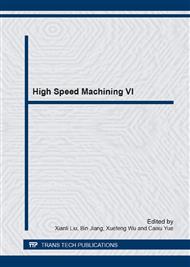p.280
p.285
p.290
p.296
p.300
p.305
p.311
p.316
p.321
Finite Element Method Simulation Study of High-Temperature Alloy Serrated Chip
Abstract:
High-temperature alloy can easily produce jagged chips in high-speed cutting conditions. The serrated chips will lead to the volatility of cutting force and impact the processing efficiency and quality. The formation mechanism of serrated chip has important significance to improve processing quality and efficiency. As the serrated chips have very short generation time, it is very hard to measure the changes of the stress, strain and temperature during the formation of serrated chips in experimental method. And it is more difficult to carry out quantitative and qualitative analysis. So it has been the research priorities and difficulties in the field of metal cutting. In this paper, both the finite element method simulation and experimental method are used to study the formation mechanism of serrated chip, deformation of material and the degree of variation of jagged. It has an important reference value to select cutting parameters for high-temperature alloy cutting.
Info:
Periodical:
Pages:
300-304
Citation:
Online since:
July 2014
Authors:
Price:
Сopyright:
© 2014 Trans Tech Publications Ltd. All Rights Reserved
Share:
Citation:


